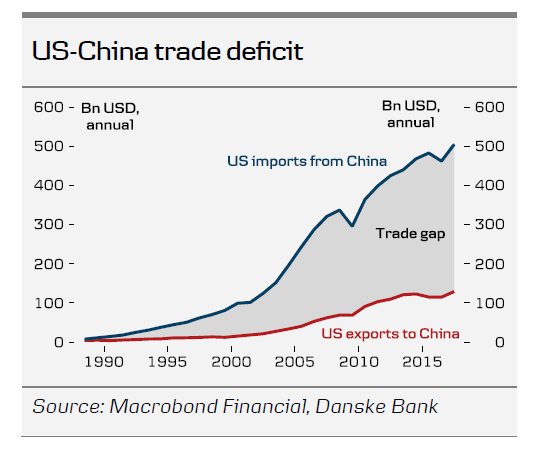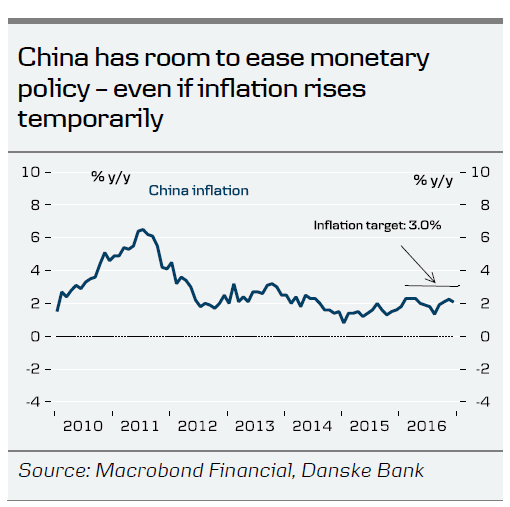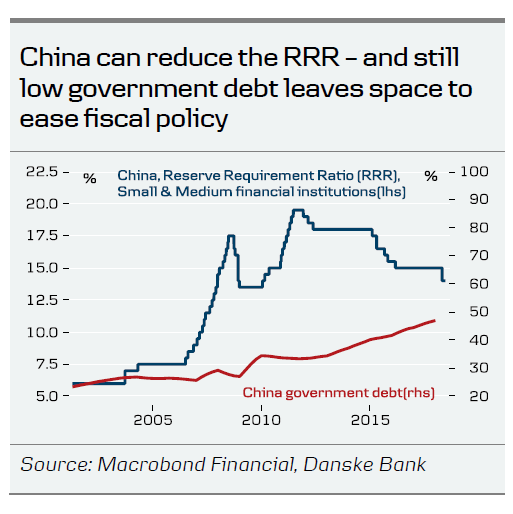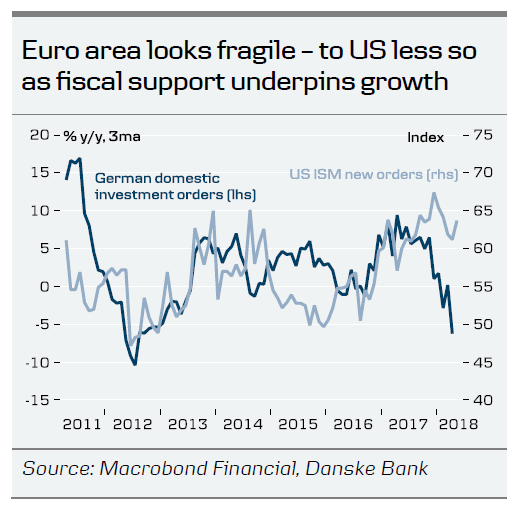- The US-China trade frictions escalated further over the weekend and we are unfortunately moving away from the ‘Grand Bargain’ scenario towards the ‘trade war’ scenario.
- While there are no winners in a trade war, the US is focused on protecting US technology and sees the tariffs on Chinese tech products as a legitimate action. China clearly disagrees, which is why we believe we are heading into a tit-for-tat scenario, in which we believe the US will soon raise the amount subject to tariffs to USD150bn.
- The Chinese retaliation pattern shows that China intends to follow Donald Trump with ‘equal scale and equal strength’ on every move he takes against China.
- Even if the amount subject to tariffs is raised to USD150bn, our rough calculations suggest it would not reduce global GDP by more than 0.2%. The calculations are very uncertain though and it is likely the effects would be front-loaded. This suggests downside risk to growth in the second half of 2018 and early 2019 but not a complete derailing of the global recovery.
- Although not part of the US-China trade spat, Europe is looking fragile as growth has already slowed and the fiscal policy is less of a support compared with the US.
Tit-for-tat just started again
While we have been arguing for a ‘Grand Bargain’ scenario since the US-China trade spat started, the recent development suggests we are moving more towards the ‘trade war’ scenario. US President Donald Trump on Friday announced 25% tariffs on Chinese goods worth USD50bn within tech products and warned that the US would impose additional tariffs should China take retaliatory measures.
However, this did not stop China from saying immediately that it would retaliate with ‘equal scale and equal strength’. On Friday evening, China announced tariffs on US products of an equal amount and implemented them on the same date (6 July) as the US intends to implement tariffs on China. At the same time, China pulled back from the deal made with the US on 21 May, which, among other things, involved buying more US products worth USD70bn. The US products subject to tariffs in China will be mainly within agriculture, seafood and autos.
With the move China sends a clear signal that it will follow Trump one-to-one on whatever move he takes against China. Although China has a total of only USD130bn to put tariffs on (versus the USD500bn of Chinese imports into the US), China has other tools to use in the trade conflict. The strongest is probably a consumer boycott of US consumer goods but it can also use restrictions on investments in China by US companies as there are far more US companies in China than the other way around.
Is China’s threat of retaliation credible?
We believe so. China has clearly stated it does not want a trade war and knows it will cause pain in the short term. However, at the same time, it has tools domestically to weather the negative effects. Monetary policy can be eased quite significantly and there is also some room to ease fiscal policy, for example by compensating sectors hurt by the tariffs and thus also dampening the inflationary effect. China is also likely to beef up even more investment in technology and innovation, as it is becoming clearer that it will be more difficult to import high-technology products from the US in the future.
In addition, China believes a trade war will be as painful for the US – not least in the longer term, as US companies will be disadvantaged in the fastest growing market in the world. China gets confidence in this from the many protests by US corporates that are against the tariffs and favour a negotiated deal. China thus sees its hand as equally strong as that of the US.
Finally, China wants to send a clear signal to the US that it will not be ‘bullied’ or accept the bypassing of the multilateral trade system through the WTO. Even if China has to pay a price in the short term, what matters for growth in the long term is China’s productivity catching up. China aims to increase productivity by investing heavily in technology and education and any negative effects of the trade war would be likely to hold back growth for a while but not stop China’s continued rise in productivity if it sticks to reforms and investment in technology and education. This is exactly why China has a strong focus on the ‘reform and opening’ policy continuing and has put focus on technology and education.
As a trade war would damage both countries, our baseline scenario has all along been that a ‘Grand Bargain’ would be the outcome. However, if Trump believes he has the strongest hand and thus will win the chicken game or the US wants to protect US technology even if it comes at a cost, then a trade war could be the outcome
What’s next? Escalation increasingly likely
So what should we look for next? There are several things that will determine whether we are heading for a real trade war.
- Will Trump increase the amount of Chinese imports subject to tariffs to USD150bn? This is probably the most important thing to watch. If so, there will be a 60-day hearing period before it can be implemented but the announcement itself would be an escalation. China would signal immediately that it would strike back with ‘equal scale and equal strength’.
- How great will the restrictions be that Trump will put on Chinese investments into the US? This will be announced on 30 June and may trigger a response from China.
- How significant will the export controls on technology products to China be? These are also set to be announced on 30 June.
- Will the US and China resume the negotiations that began in May when a Chinese delegation was in the US and two US delegations went to Beijing?
While Trump has not yet responded to China’s retaliation, we see a high probability he will announce an increase in Chinese imports subject to tariffs to USD150bn soon. We also believe he will announce quite severe restrictions on Chinese investments in the US as well as further export controls on US tech exports to China on 30 June. With China retaliating, it would lead to a further escalation and using the term ‘trade war’ would then be justified
What could stop Trump from increasing the tariff amounts? The pressure from US corporates for him to back down from a tariff war is increasing (see ‘US business leaders warn on impact of Trump tariffs’, Financial Times, 18 June). There is a possibility this could persuade Trump to back down despite his signal that he would retaliate on Chinese counter-measures.
How it will affect the global economy
As we do not know where this will end ultimately, it is hard to put any clear numbers on it. However, we can make some quick back-of-the-envelope calculations on the short-term effects. Let us start with China.
The direct effect: USD50bn corresponds to 0.4% of Chinese GDP. Assuming the import contents of exports amounts to 50% and that we see a reduction in exports of the specific goods of 25%, it would subtract 0.05 percentage points from Chinese GDP, all else being equal. However, there are likely to be multiplier effects, as lower exports mean less investments and fewer jobs and thus less consumption. Consumption would also be hurt by higher inflation as the tariffs raise consumer prices. Including this, we end up with a negative effect of 0.1% of GDP.
The indirect effect: On top of this, there is also a sentiment effect as uncertainty increases during a trade war, which would hamper investments and consumer spending in sectors other than those hit directly by the tariffs. This is very hard to gauge but we assume it would be of a similar magnitude, so shaving off 0.1% of GDP.
The reallocation effect: There could also be a positive effect on investment. If US companies see a risk the tariff wall on US products will be permanent, it will give them greater incentive to move more production to China to avoid having to pay the tariff (and vice versa). This effect would probably take time though, so we discard it here as we are focusing on the short-term effects over the next year. The above effects so far amount to around 0.2% of GDP. However, there is another mitigating effect.
The policy response: With weaker growth, the People’s Bank of China can compensate by increasing liquidity and pushing down bond yields. China could also ease fiscal policy to fill the demand gap. These measures could, in theory, compensate fully but we assume they reduce the above effects by only half.
This leaves us with a net effect of 0.1% of GDP – hardly a big deal. If the amount subject to tariffs is USD150bn instead, the effect would be three times bigger and thus close to 0.3% of Chinese GDP. It would be felt but would still not be a disaster.
For the US, it is even harder to gauge the effects (how do you calculate the effect of a potential Chinese consumer boycott?) but they will probably be smaller as a percent of GDP, simply because GDP at USD18trn is 50% higher in the US than in China, where GDP is USD12trn. Going through the same effects as with China takes us to 0.2% of GDP in the scenario of tariffs on goods worth USD150bn on US imports.
The weighted effect is thus around 0.25% of GDP and as the two countries are around 40% of global GDP, it takes us to 0.12% of global GDP. On top of this, there are likely to be negative sentiment effects in the rest of the world, which we put at 0.1% of GDP. In sum, we end up at around 0.2% of global GDP that could be shaved off in this scenario.
It is hardly a disaster but it is still likely to be felt over the next six months, as the effects will probably be front-loaded, as the impact of companies postponing investments could come quite quickly.
Europe would be hit by the sentiment effect as well as by lower growth on export markets and, given the soft data seen recently and higher uncertainty already from Italy and US tariffs, we see Europe as quite fragile in the current environment. The US is probably more resilient as the fiscal boost is currently creating some support to growth.
In the medium to longer term, a world with higher tariffs would reduce global productivity and increase inflation. It would disrupt the global supply chain that has been built up over the past few decades and while it could lead to more investment as production might move within a tariff wall, it would also imply that previous investments would have to be written off. This would hurt corporate profits and thus equities.
Why is Trump leaving the negotiation track?
Why is Trump leaving the negotiation track already, when there seemed to be agreement to stop tariff threats while negotiations were ongoing and Trump got more concessions from China than any other president has achieved?
First, Trump faced significant criticism from fellow Republicans and Democrats for the deal he made with China on 21 May. Being a long-term critic of China and heading into mid-term elections, Trump may have had second thoughts about the negotiations. Second, the US tariffs are not just about a big trade deficit with China. They are as much about a long-term rivalry between the US and China, which has intensified under the Trump administration and is set to continue as China grows bigger and in the coming decades surpasses the US as the biggest economy in the world. China is seen as a strategic rival and consensus is growing that the US needs to take action to protect US technology and respond to theft of intellectual property.
The rivalry was very clear in the US National Security Strategy from December 2017, in which Trump described China (and Russia) as a ‘revisionist power’ seeking to ‘shape a world antithetical to US values and interests’. It also said ‘We will protect our national security innovation base from those who steal our intellectual property and unfairly exploit the innovation of free societies’.
For the same reasons, the US is set to put restrictions on Chinese investments in the US, when Trump announces the result of an investigation into this area on 30 June. On the same day, the US is also scheduled to release export controls within technology. When it comes to technology, Trump will insist on protectionism versus China and the tariffs imposed now do not seem likely to be removed in a negotiation. Trump sees this protection as fully legitimate. For the same reason, he sees Chinese retaliation as illegitimate, which is why we expect him to step up tariffs further soon.


















